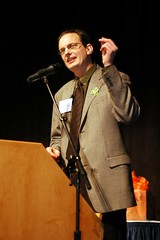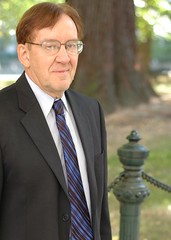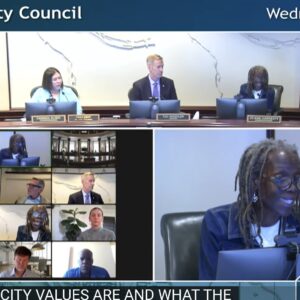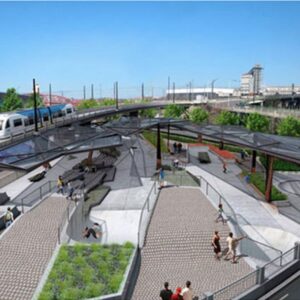“We need a replacement. But it must be the right kind of new bridge… Approval today will only move the bridge project proposal from one phase of evaluation to the next.”
–Commissioner Sam Adams in today’s Oregonian
Today is an important day for supporters and critics of the Columbia River Crossing project.
Portland City Council, the group whom many think pose the best chance at throwing a major wrench in the estimated $4.2 billion project, will vote on their “locally preferred alternative” (LPA). So far, no official agency or government body has voted against it.
But in recent weeks, opposition to the project has grown considerably and City Council has heard loud and clear that many Portlanders are concerned about moving forward.
At a press conference yesterday, a coalition of advocates and experts issued grave concerns about the project. The event was held at Piccolo Park in Southeast Portland, a site chosen for its symbolism in the defeat of a massive highway project that never got built — the Mt. Hood Freeway.
Critics feel that the CRC project team is hell-bent on building a 12-lane mega-bridge that will induce more traffic, encourage sprawl, and increase greenhouse gas emissions. But CRC staff, Commissioner Adams (see below), and other supporters of the project say that the LPA decision is simply a vote for a very preliminary phase of the project, and that the key planning decisions remain.
But even with those assurances, many see today’s vote as a last chance to stop a project that is backed by an intimidating amount of bureaucratic inertia that includes strong support from trade and business organizations and the governors and transportation departments (ODOT and WashDOT) from both Washington and Oregon.
Evan Manvel, the former director of the Bicycle Transportation Alliance and now chief policy czar for the Oregon League of Conservation Voters, wrote a guest article on BlueOregon yesterday saying that if Council votes “yes” on their CRC resolution today, they’ll miss any chance of steering the project down the road (emphasis mine):
“… the Portland City Council will vote on whether to sign off on the project (the LPA, or locally preferred alternative), based on scant and sketchy information about global warming impacts, financing, and bridge design. If they do, their role becomes advisory. They no longer have any decision-making power on the project. They can ask nicely for the bridge to look pretty, to have bike lanes of a certain width, and so forth. But they can’t make it so. So make no mistake – once local governments sign off, they’re done.”
But, in an editorial that appears in today’s Oregonian, Commissioner (and mayor-elect) Sam Adams tries to explain that a “yes” vote today will not be the last we hear from City Council. He also seems to be trying to soften the blow when he votes “yes” on the project today:
“The Portland City Council’s vote today is not the ultimate or final “yes” to begin building the new bridge. Approval today will only move the bridge project proposal from one phase of evaluation to the next. It will simply establish the assumption for the next phase of study that the existing bridge will be replaced with no more travel lanes than exist today and that it must include an expansion of light rail.”
Also in that piece Adams writes that, “the governors of Oregon and Washington, each state’s congressional delegation and local stakeholders,” have given him, “assurance… that Portland’s concerns for planning the remainder of the project details will be addressed to our satisfaction.”
Adams’ editorial seems to make it clear that he has found the support on Council to vote in favor of the CRC today.
Ron Buel, founding publisher of the Willamette Week and a veteran transportation activist who has helped thwart several massive highway projects, says even if Council votes in support of the project today, there is still a silver bullet.
Buel told me that the CRC staff has left themselves open to a legal challenge because they violated strict rules that govern the public process around these types of projects (as laid out by the National Environmental Protection Act (NEPA)).
He says the Draft Environmental Impact Statement (DEIS), a report that Council (and others) are supposed to base their LPA decisions on, has left out key information including independent analyses of greenhouse gas emissions and induced travel.
Buel also points out that the timing of City Council’s first public hearing — which is coming after they issued a letter in support of the replacement bridge option and after the official DEIS comment period has ended — presents a “dream scenario” for anyone who might seek to challenge their adherence to NEPA guidelines.
What does Buel think City Council should do? Surprisingly (and perhaps somewhat sarcastically) he says they should support the 12-lane, replacement bridge option:
“For the City, selecting the big, new Replacement Bridge is a win-win proposition. They throw red meat to the special interest groups lobbying for the $4.2 billion, 12-lane bridge. At the same time, they know the CRC can’t be financed, and that a NEPA challenge will be successful, so that it becomes a bad project that will never be built, ultimately making opponents happy.”
But what does all this say about the viability of our political process, the way our democracy works? What it says isn’t good. It’s not a winner for the public interest.”
Stay tuned for a report from City Council later today…







Thanks for reading.
BikePortland has served this community with independent community journalism since 2005. We rely on subscriptions from readers like you to survive. Your financial support is vital in keeping this valuable resource alive and well.
Please subscribe today to strengthen and expand our work.
Sam Adams says: \”the existing bridge will be replaced with no more travel lanes than exist today and that it must include an expansion of light rail.\”
I think this could be a tricky political statement, since the 12 lane bridge has been said to have the same amount of \”travel lanes\” as the 6 lane bridge (just with the addition of six extra turn/merge lanes).
By the way, the PSU Student Senate just passed a resolution asking the City of Portland to wait until further studies are done before supporting the CRC. We\’re meeting in the South Park Blocks in front of Smith Memorial Student Union at 1:30pm today to head to city hall and present our concerns.
Sounds like Sam has drunk the Cool-Aid. Although he might be right that it\’s just a preliminary vote, a No vote could sent an important symbolic statement in which the Council actually *represented* the will of Portlanders, as it is supposed to do!!
Fortunately, even though Buel has apparently taken to practicing law without a license, he\’s right about NEPA.
I guess we cannot rely on our elected officials to represent our interests and We, the People of Portland, will have to resort to fixing this billion-dollar boondoggle ourselves!
NO CRC!!
See ya in court!
Ya herd?!?!
We must stop this massive waste of public money. Setting aside the environmental concerns, the economic futility of the project is obvious just by looking at the rapidly rising cost of fuel. Are the people who call themselves \”planners\” really looking ahead to the inevitable future of prohibitively expensive fuel? Who do they expect will be using the bridge when gas costs $10 or $12 per gallon in a few years?
Those last few paragraphs are really striking, and reflect a thought I\’d had about this, that there might be more political gamesmanship going on here than is obvious. Like they vote for this thing to bolster their support from the freight and union people happy, all the while thinking the bridge will never actually get built. That would be pretty cynical.
However, it kinda makes sense, because it seems so obviously self-destructive(from a Portland point of view) to increase capacity on the crossing, thus inducing demand, thus pouring more traffic into all the other existing bottlenecks we have in town, and into downtown, which is plenty congested already.
Is Portland\’s financial well-being somehow hinging on Portlanders being able to commute to Washington? Because otherwise, it\’s just not obvious to me how the CRC does anything but damage.
$4.2 billion.
Good grief. We could buy like, 7 billion Hershey bars with that money.
I\’d rather be eating chocolate, than sitting in the new traffic jams that will soon form on this 12-lane bridge.
The good news is that traffic jams won\’t be an issue when gas costs upwards of $10/gallon, which will probably be within a few years of the CRC being completed. Maybe after it\’s completed and gas hits $12-$13/gallong then it will become a massive bicycle and pedestrian bridge!
Jonathon,
It appears that you are losing your journalistic skepticism and objectivity:
\”…building a 12-lane mega-bridge that will induce more traffic, encourage sprawl, and increase greenhouse gas emissions…\”
This is not the conclusion of the DEIS. The data shows less traffic than no-build (thanks to tolls and light rail), less sprawl (thanks again to tolling), and less greenhouse gas emissions (even not supposing a new energy source for vehicles).
I think you should be careful of straying into advocacy as your even handed approach to the issues has won you credibility among all sides of many issues relating to bicycling.
It is also curious that you haven\’t covered the bicycle angle of this project at all. Namely, there is great opportunity here to vastly improve the current scary, dangerous and intimidating river crossing and create very pedestrian and bicycle friendly communities in downtown Vancouver and on Hayden Island that the current configuration and congestion make almost impossible to achieve.
Rex
— Please note that the real Rex Burkholder has confirmed that this comment was not written by him. Also, the IP address doesn’t match with other comments the real Rex Burkholder has left.
thanks for the input Rex.
the line from my story that you cite above began with \”Critics feel that the CRC project team is hell-bent on building…\”
I was citing the feelings of critics of the project, I was not making a statement of my own. If that was unclear, than its my mistake.
you also write that,
\”it is also curious that you haven\’t covered the bicycle angle of this project at all.
that is simply not the case.
Besides covering every move the BTA has (or hasn\’t) made on this issue from the start (my first story about the CRC was published in Feb. 2007), I have also reported on updates from the CRC\’s bike/ped advisory committee.
Most recently, I shared that committees recommendations along with a sketch of their latest vision for the bike/ped facility design.
I\’ve written 38 stories on the CRC. looking further into the archives I find these bike-related stories:
— New I-5 bridge: What’s in store for bikes? (1/21/08)
— Picture a world-class Columbia River bridge (1/29/08)
— More samples of the CRC’s bike/ped design inspirations (1/31/08)
— Guest article: What the proposed CRC bridge really gives bicyclists (4/15/08)
— Making sense of bikes in the CRC DEIS (6/3/08)
again, as you know, I am increasingly trying to remain objective on the issues and I appreciate your feedback.
Rex, the DEIS shows less traffic, sprawl, and GHG emissions because it has failed to adequately model the situation, as required by federal law, and because it makes assumptions that may or may not be applicable to the bridge as eventually constructed.
I think *you* should be careful posting what are pretty obviously misleading comments on bikeportland. This readership is not the average citizenry that is apathetic and easily fooled by your manipulation of complex information and your careful omissions of pertinent information.
Someone as educated and politically experienced as yourself should know better than to make such assertions. Your post above (#7) is intentionally misleading and made for your own political gain.
You should avoid lecturing people about \”credibility\” and \”straying into advocacy\” when you are clearly doing exactly that yourself. Why don\’t you publicly disclose all the contacts you\’ve had with proponents of this project and the substance of those contacts with regard to your role?
You\’re welcome to serve the interests of your corporate overlords instead of the public good if you wish, but don\’t expect us to buy it. Go sell your snake oil to the Oregonian.
Finally, if you had been paying attention you would know that Jonathan *has* covered the bike facilities of the CRC. That\’s the final nail in the coffin of your shameful attempt to personally attack Jonathan.
Ironically, you wouldn\’t be making such ad hominem attacks if you didn\’t know that Jonathan is raising awareness of this billion dollar boondoggle you are attempting to foist on the unsuspecting public.
Whatever respect I once had for you is now gone, sir.
Rex, since I know you are reading this, lets talk about axillary lanes for a moment. Most of us know what an axillary lane is, there is one on I-5 between the interchanges at Lombard and Rosa Parks, it is 2000 feet long or so, enough room to merge, but not so long that anyone would use it for anything else. One of the \”axillary lanes\” on the CRC is 5 miles long. I-405 (a nationally designated interstate freeway) is 4 miles long, and it has 2 through lanes plus some axillary ones as well. So how can you call something an axillary lane when it is actually longer than an entire freeway?
Wow. I guess its now OK to take off the kid gloves regarding this particular piece of politics.
Rex,
I first learned about the new CRC via the articles posted right here on BikePortland.org, back in January. My first impression – thanks to Jonathan\’s reporting – was that the CRC would have, \”world-class\” bike and ped facilities. My initial impression of the bike lanes themselves, despite my aversion to big highway projects, was pretty positive.
The more I learned about the megabridge CRC, however, the less I came to care about those bike lanes. They\’d be *nice*, but only at a reasonable cost.
If the cost of world-class bike lanes is a 12-lane, fund-hogging, sprawl-promoting monstrosity, then no thanks.
I also don\’t see the great demand for bikes to cross the Columbia. I mean, again, it would be *nice* if they could, but is it the most pressing need for bike-friendly infrastructure?
You say:
\”Namely, there is great opportunity here to vastly improve the current scary, dangerous and intimidating river crossing and create very pedestrian and bicycle friendly communities in downtown Vancouver and on Hayden Island that the current configuration and congestion make almost impossible to achieve.\”
See, I\’m just not getting that. I live in a bike-friendly neighborhood – near Hawthorne, around Mt. Tabor – and what makes it bike-friendly is having all my needs and wants – stores, banks, pharmacies, libraries, schools, theaters, hospitals, my work – within a .5 to 1 mile radius. All in what is essentially a 1910 suburb: pleasant, but compact. I planned this out before I moved here. I bought a house in this location so I could live this way. It cost a little extra, but I budgeted to make it happen.
I invested in my own personal, bike-friendly infrastructure, and it\’s paying off.
If someone built a new bridge adjacent to my neighborhood, one that poured a ton more traffic into my neighborhood, it would certainly not make my \’hood more bike-friendly. Even if some fraction of that traffic influx was bicycles.
If you want to make Hayden Island more bike-friendly, make it so that people can live their lives without having to travel vast distances – over massive highway bridges – on and off that island to do so.
Same goes for Vancouver. Same goes for every town in this sprawl-plagued, carbon-spewing country.
We need to start living closer to home.
There\’s a City Council video link here: http://www.portlandonline.com/index.cfm?c=28258. It\’ll be streaming live at 2pm, apparently.
A nice option for those of us who can\’t make the meeting. I hope it actually works 🙂
Graham & A.O:
Very well said. It\’s about time these lazy assumptions supported only by bureaucratic wishful thinking got smacked down.
Actually, I am appalled that anyone could actually say \”The data shows less traffic than no-build (thanks to tolls and light rail), less sprawl (thanks again to tolling), and less greenhouse gas emissions (even not supposing a new energy source for vehicles)\” with a straight face.
Let\’s take the business of tolling right out of that quote. We could toll the current bridge just as easily, if we really cared to control sprawl and greenhouse gas emissions. Why would we need to add capacity and then throttle back the traffic by tolling? That makes no sense. The only way there could be less sprawl or emissions is with fewer trips across the bridge, and if that\’s so why on earth should we be building more lanes? Unless of course the real point of the CRC is to spend $4.2+ billion of our money?
Anyway, data is the plural, so data show.
Rex B: Wrong on the facts, wrong on the grammar!
If the cost of world-class bike lanes is a 12-lane, fund-hogging, sprawl-promoting monstrosity, then no thanks.
Amen to that. Furthermore, no conscientious steward of public funds would support such a monstrous boondoggle as we enter what may well turn out to be the worst recession this country has seen since the Great Depression.
Oh, and can we stop saying $4.2 billion? Because we all know it\’ll be more like $6 to $8 billion, unless they find some accounting trick to hide the overruns. Wait: that\’s the first thing they figured out!
Jonathan,
Sorry about the mistaken comments about your coverage of the bicycle/ped components. You proved me wrong. Must be the 1 hour of sleep last night.
Now, for all those who say that I\’ve misstated the data: these points come directly from the Draft Environmental Impact Statement which I reviewed (all 500 pages) in preparing the resolution that the Metro Council adopted 5-2. I also sat on the Task Force for 3 years, studying the same issues and asking the same questions. 37 of my co-members of the 39 member task force agreed with the final decision to proceed, with many of the same caveats and concerns raised by me, Metro and the City of Portland.
Slogans and personal attacks make for demagoguery and bad public policy. Especially when uninformed.
Rex,
With all due respect, my dear friend (and I\’ve probably known you longer than just about anyone reading this), it boggles my mind that you would still defend the data in the draft EIS after it (and you) were so thoroughly dissected by Joe Cortright at the City Club recently. (I have it on DVD if you need to borrow it. It\’s not pretty, Rex, but Joe speaks truth to power.)
Garbage in, garbage out, Rex…assumptions of $1.25 per gallon gas? No modeling of alternative land use patterns impact on travel demand? That\’s just for starters.
I, like many, don\’t understand why you drank the kool aid. But to claim any critical comment is uninformed is is defendive, silly & frankly, just not true. You were totally uninformed about Jonathan\’s coverage on the issue. It\’s not a lack of sleep you suffer from. If only that were the problem.
Hi Rex,
Not really replying to your above post, just something I\’ve been wondering about:
I saw your debate with Joe Cortright at the City Club, and at one point he brought up the Oregonian article which said:
\”traffic forecasters involved in planning a new bridge, projected to cost $4.2 billion, were told to assume a new 12-lane bridge would not trigger any more growth than if the current bridge were simply left in place. Yet a 12-lane bridge would handle 40 percent more cars during afternoon rush hour, according to the forecasters\’ calculations.\”
http://www.oregonlive.com/news/oregonian/index.ssf?/base/news/1214029515244280.xml&coll=7
I found the article kind of shocking because induced demand (\”if you build it, they will come\”) is such an intuitively obvious result of the mega-bridge option. For the forecasters to be told not to take this into account would seem to be a pretty major oversight.
I remember your reply to Mr. Cortright was something along the lines of: don\’t believe everything you read in the paper. Had I been a City Club member (and thus able to ask questions), I\’d have asked for you to elaborate.
If you\’re still around and up for posting, I\’d genuinely like to hear what you thought were the flaws in the article.
#7 \”This is not the conclusion of the DEIS. The data shows … less sprawl (thanks again to tolling).\”
No it doesn\’t. It wasn\’t studied in the DEIS at all. The DEIS made the assumption that a new bridge wouldn\’t increase sprawl by using the same land use model for both the build and no build alternatives. And that is a mistake, all transportation systems have impact on land use, that is the entire point of building them. (Even things as small as a bike blvd have impacts on house prices in the neighborhood.) The fact that that wasn\’t studied is the focus of several newspaper articles (including ones that quote you) and is also the focus of many of the public comments the CRC received on the DEIS, including from the US EPA:
\”We think more work is needed to evaluate the travel and land use change that would be stimulated … and their associated impacts upon air, water, and land resources, as well as their socio-economic and human health effects.\”
#17 \”Slogans and personal attacks make for demagoguery and bad public policy. Especially when uninformed.\”
I totally agree.
i am a little stunned by how bad the info in the DEIS is. apparently they made the estimate that gas would cost $1.25/gallon?!?
The CRC people are either incompetent or intentionally trying to mislead us. Either way we should be highly vigilant about this program and demand better results.
Rex, thanks for weighing in. Id really like to understand more about what it means to be an \”axillary\” lane. Is Matthew Denton (#10) right?
Rex:
I did not read all 500 pages of the report, but since you have, please explain to me this: how can increased capacity not yield more VMT? And if it doesn\’t, what are the material gains that the CRC offers which make it worth the price tag? Please assume that the funding for this doesn\’t come out of thin air, but instead from real sources, which could be going to other transportation projects in the area.
Also, please answer the question posed by Matthew Denton at comment #10. When does an auxiliary lane just become another through lane? Does it not induce more traffic even if it does not cross the river?
No it doesn\’t. It wasn\’t studied in the DEIS at all. The DEIS made the assumption that a new bridge wouldn\’t increase sprawl by using the same land use model for both the build and no build alternatives.
Well, a new bridge with transit to Vancouver City Center and better access to and from it will likely skyrocket Vancouver to being a major city. How about we model the CRC as making Vancouver more attractive for employers, since their employees will be less likely to be stuck in unexpected traffic?
How about we model how the Boise-Cascade site will grow out the Couv also? Don\’t forget Block 10 and the Mill Plain corridors also. There\’s a lot of growth potential if we make Vancouver a bit more accessible.
I think a great plan would be the I-5 bridge AND a new BNSF/local arterial bridge combo. It would allow better access to the Couv, while improving I-5 to seismic standards and traffic flow.
The auxiliary lanes, while long, are like those on the I-205 bridge. The rightmost lane of the 4 facing southbound is an aux lane to PDX, the northbound 4th lane is for SR-14. The CRC just looks at flow impacts more efficiently.